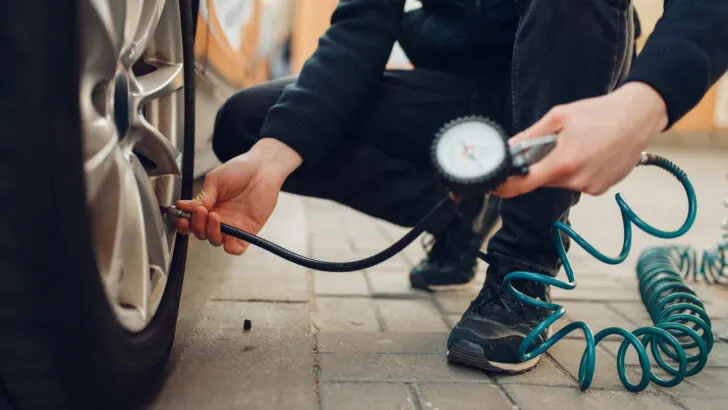The tires on our vehicles may get flat due to punctures or tire bursts while we’re on the road or when the car is left to sit in the garage for extended periods of time.
If you’ve noticed that one or two tires are flat, the best thing is to pull over if you’re driving, or change the tire before driving off if you noticed it before you left.
But, like you, most drivers question whether they can move their car some distance on a flat tire.
Moving your car with a flat tire for short distances of less than 100 yards is possible. Any distances after that damage the tires, rims, and even the drivetrain in all-wheel-drive vehicles.
Furthermore, driving with a flat tire is classified as unsafe, and you’ll face legal consequences if you cause a road accident.
So, if you have a flat tire, what should you do? Read on to find out.
Table of Contents
Should You Move A Car With A Flat Tire?
Having a flat tire is an inconvenience we all experience at one point in our drive. Whether it results from a puncture or a tire burst, driving on a flat tire is costly and dangerous to you and other road users.
But does it mean that you should immediately stop after you notice that you have a flat tire? That may not always be safe either.
If you realize your car has a flat tire while driving, here’s what you should do.
- Brake gently, and pull over to a safe place on the side of the road
- Turn on your hazard lights to inform other road users
- Inspect the tire damage
- Replace the flat tire with a spare one
- If changing the tire isn’t possible, call roadside assistance to aid you with the tire change
What About Run-Flat Tires?
If your car has run-flat tires, you can drive for an additional 50 miles at speeds of less than 50 miles per hour after the puncture.
Run-flat tires have extra strong rubber and thicker side walls than the normal tires on our cars. Some even have a hard rubber ring around the rim to protect it from damage when the tire gets flat.
But that doesn’t mean you should drive for 50 miles on a flat tire. Run-flat tires ensure you drive safely to the nearest service station for a tire change.
After the rated range, the run-flat tires will start degrading and will cost you more to replace, as they’re approximately 30% costlier than the regular tires.
How to Avoid Driving on a Flat Tire
A flat tire can sometimes result from driver negligence and failure to routinely maintain a car's tires.
Some may even underestimate the damages resulting from running on flat tires and pay thousands of dollars for repairs.
Most car insurance companies won’t cover tire damage, as they consider it normal wear and tear. However, with a little precaution and routine care, you can keep your tires running well and avoid these costly damages.
Here are ways to avoid finding yourself with a flat tire.

Check the Tire Pressure Monthly
We often tend to underappreciate our vehicle’s tires until they run flat. According to the National Highway Traffic Safety Administration (NHTSA), we should check the pressure of all our tires at least once a month.
Driving on low-pressure tires can be dangerous, affecting our braking distances as well as steering and handling.
Luckily, modern vehicles have Tire Pressure Monitoring Systems (TPMS) that warn you when the tire pressure is low.
However, the TPMS may fail to warn you until the tires have lost a significant percentage of their pressure. This then increases the chances of running on a flat tire.
And you can prevent this by using a tire pressure gauge to check that your tires are at the recommended pressure (check the owner’s manual).
Also, don’t check the pressure on hot tires, as you may find an incorrect reading higher than what it actually is.
Don’t Overload Your Vehicle
The tire load index is a figure that guides you on the maximum weight that your vehicle can support at the right tire pressure and size.
Why is it important? Because overloading your tires is never a good idea and it can be a recipe for disaster as you wear them down quickly and risk experiencing a tire blowout.
Look at your owner’s manual for the tire load index and keep the figure in mind. It’s important, especially when you want to utilize your vehicle’s payload capacity while still being safe.

Be Cautious While Driving
Most flat tires result from punctures by sharp objects such as nails, glass, and screws left on the road.
And as they’re usually smaller objects, most drivers may not see the hazardous objects until it’s too late and they already have a punctured tire.
Avoid areas close to active construction sites and running over potholes and debris as a driver.
Inspect and Rotate Tires When Necessary
We recommend rotating your tires every 3,000 to 5,000 miles to give them a chance to wear out evenly and prolong their lifespans.
Depending on your vehicle's drivetrain, whether it is an all-wheel-, front-wheel-, or rear-wheel drive, tires will wear at different rates.
For example, a front-wheel drive car uses the front wheels to steer, brake, and move while carrying more weight from the front-mounted transaxle and engine.
Consequently, the greater load results in more wear than the rear tires. If you don’t drive frequently, then you should rotate your tires at least twice every year or once every six months.
It’s also good to inspect them for signs of damage, as they should be free from bulging side walls, bubbles, and cracks.
Consequences of Driving With a Flat Tire
It’s safe to drive with a flat tire for a short distance and at low speeds, typically less than 20 miles per hour.
Having a flat tire while in the middle of the road doesn’t mean you should park it there and wait for a mechanic or a tow truck. It would be unsafe to do so as you’re endangering the lives of other road users.
The NHTSA recommends that you can drive on a flat tire just enough to get your vehicle off the road to a safe place.
But what if you opt to keep on driving? Here are the consequences you might face.
Extensive Damages
Driving on a flat tire degrades it, exposing and bending the rim. Consequently, you’ll pay more for repairs as you have rendered your tires “unpatchable.”
Also, without the air cushion, your car’s weight rests on the rim, and the resultant shocks from the uneven road surface may damage your car’s axle, calipers, rotors, and suspension.
Noise
Driving on a flat tire is noisy, and you can easily tell a car running on it from the noise it makes.
This is due to the rim running on the rubber, which rolls on the road surface producing a distinctive sound. On the brighter side, the noise can be an easy indicator to inform you of a flat tire.
Accidents
A car with a flat tire may be unbalanced and start wobbling, making it hard to steer in a straight line.
Additionally, the damages to internal structures or the rim could cause your vehicle to lose control and sway off its intended path.
The results are usually catastrophic, and you’ll be liable for all damages due to your negligence.
Final Thoughts on Driving With a Flat Tire
Driving on a flat tire is very dangerous, and you should only do so when necessary. In all other cases, drive for a distance that allows you to get off the road to a safer location.
Don’t park around corners or in areas of poor visibility, as you will endanger other road users. Afterward, call roadside assistance or a mechanic to replace your tire.
If you found this article helpful, make sure to take a look at some of my other related articles below!
